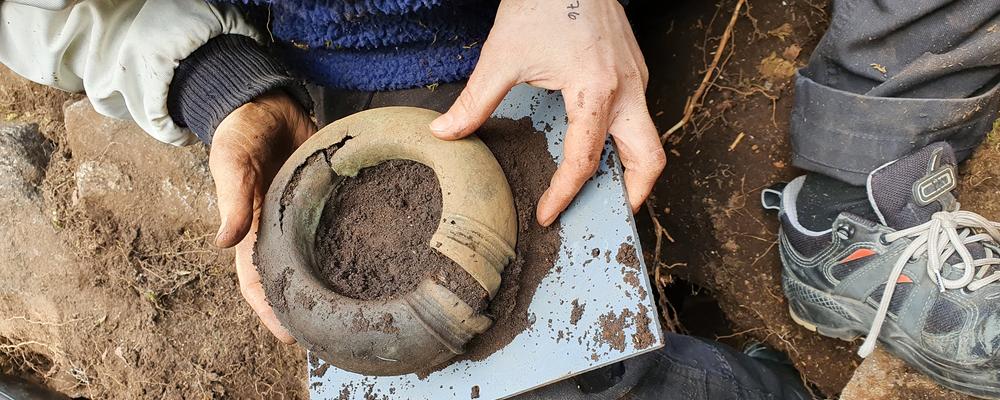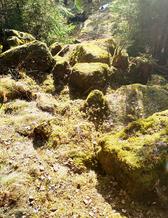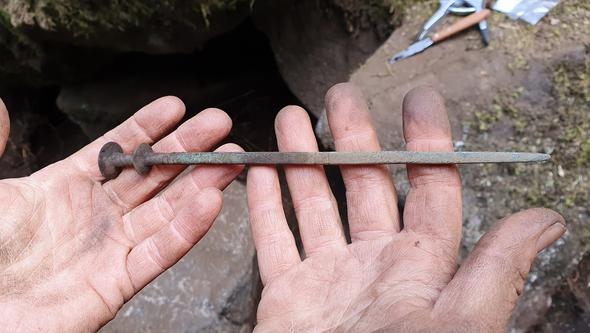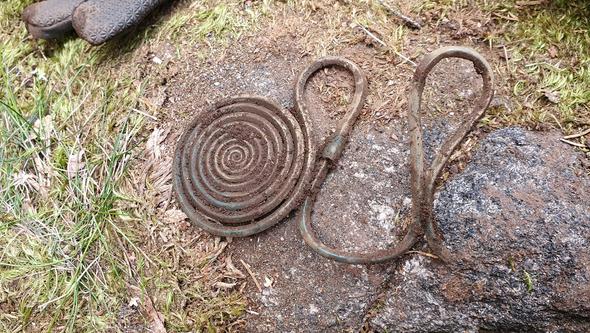
- Home
- News and events
- Find news
- Unique Bronze Age find just south of Alingsås
Unique Bronze Age find just south of Alingsås
A unique Bronze Age find was made on 8 April in a wooded area just to the south of the town of Alingsås. Following an archaeological examination by among others Johan Ling, Professor of Archaeology at the University of Gothenburg among others, it has emerged that this is one of the most spectacular finds ever made in Sweden. It comprises around 50 artefacts that are all largely intact. These exclusive objects would have belonged to one or more high-status women in the Bronze Age.
The discovery was announced at an online press conference on Thursday 29 April that was streamed by more than 1,300 people.
A member of the public contacted the County Administrative Board after they happened on around 10 artefacts which had been uncovered by some kind of animal.
“Once it became apparent that this might be a hoard, the decision was taken to carry out an archaeological dig,” says Pernilla Morner, Curator at the Cultural Environment unit of the Västra Götaland County Administrative Board.
Mats Hellgren, an archaeologist working at the Cultural Affairs Committee within Region Västra Götaland, accompanied the member of the public who found the objects to the site and noted that the artefacts were of fantastic quality.
“Initially I thought these might be recent copies, but that turned out not to be the case,” he says.
Approximately 50 artefacts found around burrow

During the subsequent archaeological dig which has now concluded, a total of around 50 artefacts were found. About 80 per cent of these were found outside a burrow, while the remainder were found under a large boulder inside the burrow.
The area in which the objects were found is not near to any previously known settlements.
What has fascinated researchers and conservators the most is not only the quantity of objects, but also their condition.
“All the artefacts were essentially intact. For them to be so well preserved is unique, and it is likely they would have remained there unless an animal had decided to build its nest there,” says Madelene Skogberg, conservator at the Cultural Affairs Committee within Region Västra Götaland.
Contemporary archaeological methods
The coming process to preserve these artefacts will seek to bring out the ornamentation, etc.
“There are several interesting dimensions to this from a research perspective. This find poses whole new questions,” says Johan Ling, Professor of Archaeology at the University of Gothenburg, who participated in the dig.

The dig utilised contemporary archaeological methods, which offer a significant advantage in comparison with Bronze Age finds discovered 100-200 years ago. For example, the team used laser scanning and analysed the soil they had lain in. Half of the artefacts would not have been found without metal detectors.
“The artefacts are from the Late Nordic Bronze Age, approximately 700-500 BCE. At the very least, this is in the top three of the best finds ever. They are extremely exclusive objects,” says Johan Ling.
“They have also been in extremely good conditions for their preservation. It is very rare to see quality of this kind.”

The objects were worn by one or more high-status women in the Bronze Age and were used to signal their social position.
“They would have worn them from head to toe! We have recovered torcs, large armlets, spiral brooches (fibulae) and clasps which were used for textiles. The most special of all are the large, essentially intact anklets that would have been worn by the women,” says Johan Ling.
In addition to torcs, cloak pins, spiral brooches, chains and a tutulus (another type of brooch worn ornamentally by women on their clothing or belt), a celt (a hollow axe) was found along with residue from castings in bronze. Also uncovered was a goad that it is believed was used to spur horses. This type of artefact has been previously found in Denmark, but not in Sweden until now.
More work to be done
These types of artefacts are common finds in northern Germany and Poland.
“This demonstrates that there was some degree of contact with these groups,” says Johan Ling.
There now remains a significant volume of analyses to be carried out, and Johan Ling believes it is important to carry out a more targeted investigation of the area to see whether there may be other hoards.
The artefacts that have been found are part of what is known as a “hoard”, which means the artefacts were intentionally placed there.
“This may have been in connection with a burial in order to facilitate their use in the afterlife. But more likely as a way of signalling their status: “I can afford to sacrifice some of my affluence!”.
The conservation of the finds will be a fairly lengthy process and their future after that process remains undetermined. That decision will be up to the Swedish National Heritage Board to make, but it is likely they will end up in a history museum, quite possibly in the region.
As this is a find of precious metals, the state is entitled to redeem them. This means that they will now be valued in order to determine their market value, and it will then be the responsibility of the Swedish National Heritage Board to address the matter of remuneration for the man who found them in the woods south of Alingsås.
Text: Johanna Hillgren

